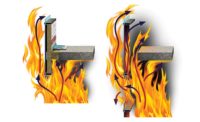Over the past few years, due to increased concern about indoor air quality, construction dust has gone from being a nuisance to becoming a liability for a contractor. In addition to causing health issues and damaging sensitive equipment, if left unmanaged, dust can threaten your company.
Clients now demand more from you because greater demands are being placed on them. The days of “just accept this inconvenience” are gone because the issues of construction have been magnified by EPA, OHSA, lawsuits and building occupants. These risks grow as the number of people around your job site increases, especially if an occupant suffers from asthma, allergies, heart disease or any other serious health conditions.
When you’re renovating an occupied office, multi-unit residential or commercial building, it’s likely that office workers or nearby residents will continue their daily lives in the building while you work. To ensure that your work doesn’t trigger a crisis, you need to proactively address potential issues and eliminate them before they cause a problem or safety concern.
Setting the Standard
A good example of the sensitivity to job site related health issues occurred early in my career. The project was in the lobby of a government office building. During our site preparation, scaffolding, equipment and several large buckets of unopened paint were brought on to the job site. Within an hour employees inside the building started complaining of headaches from paint fumes, even though we hadn’t opened the buckets yet.
This incident has stayed with me throughout my career because it continues to remind me that you can never be too careful and hypersensitive to the needs of people surrounding a job. Whether it is paint fumes, noise, dust or any number of other things, going above and beyond to minimize issues is a must, and this action is what sets you apart from the competition.
Improving Client Satisfaction
Businesses can ensure high levels of customer satisfaction by caring about issues and how they affect their clients. Contractors are compliant to rules and codes, and they are clean. For many clients and occupants, your ability to manage the dust is an indication of your overall work. Doing high-quality work, putting others first and keeping the job site functional through safe and clean practices speaks volumes about your business. Some ways to ensure that your contracting practices are sending the right message:
Be conscientious.
Keep up with changing industry rules and regulations to ensure the safety of everyone around a job site. Make sure you have business insurance and all necessary permits and certifications required for a project to protect yourself and your clients from safety and legal issues.
Communicate.
Show your customers you care by proactively discussing a strategy for keeping the space safe and comfortable that works for them and their neighbors. Talk to building management about scheduling, logistics and any potential concerns.
Control dust.
Ensure good indoor air quality by containing your job site dust and eliminating it before it can spread throughout a room or building. According to a study by MMR Research Associates, Inc., 68 percent of clients who have completed a project were displeased with how dust was managed. Typically, with larger new construction and build-out projects, contractors will have a dust elimination program already in place. However, for a smaller buildout, renovation or repair project, you might not be prepared to bring a 200 pound air scrubber. In that case, you should have access to portable and effective dust-removal technology to eliminate hazards contaminating the air. For example, the BuildClean Dust Control System eliminates up to 90 percent of airborne dust on the job site.
Train your team.
Make sure every person on your team is trained on the importance of mindful contracting. Your sales team, construction managers and designers should understand your dust control plan and the value it adds for clients, property managers and building owners. Show them how to talk to prospective and current clients about a livability strategy, which includes a plan for scheduling, logistics and dust control.
Build your reputation.
As a business owner, your reputation means everything. Leverage word-of-mouth and use it to your advantage. When your clients talk about your business, make sure they bring up your superb quality of work and cleanliness. Your excellent customer service, attention to detail and livable project plan can lead to more frequent and better referrals.
Competitive Edge
Dust is a liability – don’t let it threaten your business. Instead, make it a differentiating focal point by being proactive. Giving your customers peace of mind through a clean and safe project goes a long way in building your business and reputation. W&C
For more information, visit buildclean.com.
Dust Control Checklist:
- Isolate the Work Area: Close doors, create temporary walls, designate a main entryway to the work area, and use poly sheeting to isolate the work area.
- Seal Vents and the Heating/Cooling System: Registers and air returns in the work area should be closed and sealed regardless of whether the heating or cooling system is running. Air filters should be changed during and after construction.
- Control Building Airflow: Establish a negative air pressure environment, maintain good ventilation, circulate clean outdoor air in during and immediately after work is completed.
- Capture Airborne Dust: Use HEPA air scrubbers or negative air machines and remember to replace the pre-filter often to protect and extend the life of the HEPA filter.






Report Abusive Comment